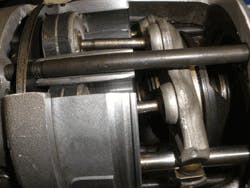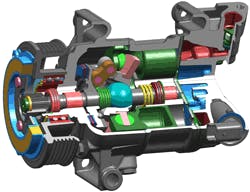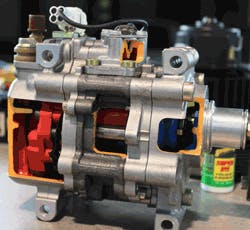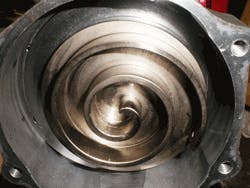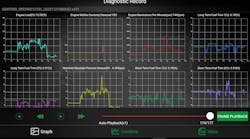Ever wonder why HVAC systems are getting such low charge capacities from the factory? Do you have customers that seem to complain about hit and miss fuel economy on their hybrid electric vehicles? Have you run into RECIRC buttons that didn't seem to stay in recirculation mode or encounter a condenser that had refrigerant passages that were smaller than a needle? The OEMs have answers for every one of these questions and those answers aren't always about improving the car maker's profits.
The answer is often rooted in fuel economy. Everyone knows that automotive air conditioning and fuel economy are not friends. Want to get better economy? Turn off the A/C. It's that simple. But most people would rather stay cool than save fuel. OEMs today are working hard at doing both. Ever since CAFE began to stand for Corporate Average Fuel Economy instead of a place to get a bite to eat, vehicle manufacturers have strived to avoid the federal government imposed fine for every 0.1 mpg they exceed the magic CAFE number. These fines are levied for each vehicle they sell in a model year in which they miss that CAFE mark.
That mark is the average of all the gas guzzlers and economic models sold. If you're going to sell large comfortable vehicles that buyers want, you're going to have to have a lot of small improvements in fuel economy that all add up. To help you have a better idea of what is going on today with A/C technology (and problems) let's quickly review the past, focus on the present and peak at the future regarding how vehicles are supposed to save fuel and still keep us cool.
History – The Birth of Cycling Clutches
Many techs wrenching today don't remember Pilot Operated Absolute (POA) valves. They were common components before cycling clutches and variable displacement compressors. In those days (1960s and 1970s), the compressor ran all the time when the HVAC control head was set to an A/C or even defrost setting (to dehumidify the air in defrost). On some luxury models, the compressors ran all the time, period.
The Birth of Variable Displacement Compressors
In effort to allow a lower load on the engine and still keep the evaporator cold but not freezing (keep cool and save fuel), the variable displacement compressor became the invention mothered by necessity. Many of us recall that annoying surge on CCOT systems when engines were downsized to increase CAFE. Those fuel sipping transverse mounted engines were first to receive the variable displacement compressor to prevent the impact of 100 percent on vs. 100 percent off compressor load. Although those compressors have been out for over a decade a learning curve still exists.
A CAFE Favorite: The Wobble Plate Special
Axial style compressors (using no conventional crankshaft) have been around since the early 1960’s when the Frigidaire A6 compressor came out. It had a swash plate that wobbled back and forth to cause the six pistons inside the compressor to move their full stroke at all times. Those old compressors were physically large and heavy — well more than 30 pounds and the full stroke at all times required a lot of energy for the engine to turn.
Moving to today’s variable displacement axial compressors, the heart of these lighter and easier to turn compressors is the wobble plate. Similar to the A6’s swash plate, this plate has the pistons attached via connecting rods. When the wobble plate is at an angle greater than 90 degrees in relationship to the input shaft, it wobbles back and forth causing the pistons to move back and forth in their stroke. When the wobble plate is nearly 90 degrees in relationship to the input shaft, it has very little wobble to it, therefore the pistons make a very slight movement back and forth in their stroke. A single shaft with a brass bushing for the plate to angle back and forth on kept the plate at the desired angle controlled by the valve in the side/back of the compressor.
Diagnosing Variable Displacement Compressors
Here is where the rubber meets the road. If you are used to reading pressures on your gauge set as your only method for determining system charge and component restrictions, you are going to need to make some adjustments. If a variable displacement compressor’s wobble plate gets stuck in a lower displacement position, cooling will be poor and both the high and low sides will be low as if you had a low charge or a bad compressor. If the wobble plate gets stuck in a high displacement position, you will have the symptom of a restricted / froze up evaporator.
Because a low charges and over charges can emulate other problems, you are time ahead to do a recovery and recharge with the correct amount of refrigerant to set a baseline. Now if you don’t see any component freeze up spots indicating a restriction and it appears the compressor is not pumping any or not throttling back to prevent too much of a drop on the low side, then you likely have a compressor displacement control problem. If the displacement control is electronic (we’ll cover that next), you naturally would check that out prior to going after the compressor.
The Death of Compressor Clutches
Many mpg conscience models have dropped the spare tire and jack in favor of a compressor with tire sealant or run flat tires. Lighter rims, aluminum body panels and more and more composites (what engineers call plastic) throughout the vehicle all add up the weight loss CAFE diet. Even CD players have been lightened up along with of course more multiplexing (CAN networks) to reduce the weight from wiring. So there is one word on why A/C compressor clutches are disappearing – weight.
A typical clutch, bearing and coil weigh about five pounds. That’s about what a laptop computer weighs. Subtract the weight of the pulley and doing away with a clutch drops two or three pounds from the car. The advantage of a consistent load comes into play when the clutch is gone but a slight penalty in winter for a little more drag factors in. There has to be a protection mechanism such as a shear pin to allow the accessory drive belt to continue operation in event the compressor locks up.
In order to go clutchless, the PCM and HVAC controls have to have an alternative method of controlling when the compressor runs and how hard it works. Electronic control of the variable displacement side of the compressor is how it’s done. Variety abounds as always. For example, GM has adopted a CVC solenoid. Toyota has done the same. Scan tool PIDs for the newer GM compressors display duty cycle percentage for the solenoid controlling the compressor displacement.
Using the “P” word again (politics), the feds and folks at the California Air Resource Board (CARB) always are on the prowl to create requirements that drive fuel economy up and emissions down. Future CAFE requirements are the biggest hurdles seen by automakers in decades. Car makers don’t like to be caught off guard paying fines for every vehicle they sell when CAFE standards are met so the quest goes on to reduce fuel consumption and tail pipe emissions.
Electric compressors are the standard now for all but the wimpiest hybrids (GM Malibu, Saturn Vue Greenline, etc.) but that wasn’t always the case. Ford midsize hybrid SUVs (Escape and Mariner) used a mechanical compressor from 2005 until 2009. Some Hondas used a compressor that was 2/3 mechanical belt driven with the remaining rear 1/3 of the compressor being orange cable/high voltage (HV) fed. On those early Fords and the GM BAS/E-Assist (Belt Alternator Starter), if you have a customer that complains of insufficient cooling or reduced fuel economy, the usual suspect still apply along with a very simple solution — education.
To bring as good of fuel economy into summertime driving as possible periods of idle stop are favored over the most aggressive compressor operation. On these vehicles, because the compressors are mechanical, the engine (or internal combustion engine (ICE)) must remain running at stoplights. This is exactly what you do not want to do if you are going for fuel economy.
HEVs often get more impressive economy in city driving than highway driving because of regenerative braking and idle stop. Owner’s manuals for HEVs with mechanical compressors clearly describe the two modes for A/C operation. As an HEV technician, you must understand HVAC controls for hybrids due to the fact many of your customers don’t read their owner’s manuals. GM BAS systems use a bi-colored LED to indicate “Econ” (green) or “Max” (orange) A/C compressor modes.
In the econ mode, the ICE will enter idle stop. As the refrigerant warms up from lack of circulation, an evaporator temp sensor signals the HVAC controls that the evaporator is getting too warm and the PCM commands idle stop to discontinue. The ICE (and mechanical compressor) restarts and it’s back to staying cool. Your customer might notice the drop in cooling performance though. On the flip side if it’s hot enough outside that you don’t care about passing Shell stations and hugging trees the “Max” compressor mode totally inhibits idle stop.
Electric Compressors
Twelve volts is not an efficient choice for powering an electric A/C compressor explaining why they’ve never caught on although moving coolant with a 12-volt pump works just fine. HEVs supporting 100 or more volts are perfect candidates for the CAFE stretching electric A/C compressor however. These compressors can run with the ICE off. It is normal to hear a slight growl from these high speed motorized compressors.
Toyota owners were given a choice on the Generation III models (2010 and newer) between hearing a little bit of noise (some owners found it objectionable) and having cold air or having a little quieter cabin during idle stop at the expense of a little A/C performance. A TSB instructed that discussion between techs and owners prior to a HVAC module reflash that slowed down the compressor a bit. A/C compressors will bring down the State Of Charge (SOC) on the HV battery pack and that will make the ICE run as will a request for heat in cool weather.
The HVAC in any vehicle relies on the warmth of the coolant when the engine is running. Toyota and Lexus use PTC heaters mounted near their heater duct outlets to supplement engine coolant supplied heat. This isn’t just a hybrid thing either. Other non-HEVs are using this technology of 12-volt supplied electric heater as well. Fewer than 100 watts will not warm you toasty warm, but it will help take the edge off the cold until the coolant warms up with engine operation. On PHEVs and EVs, cabin preconditioning is very important to program into the vehicle for those hours while the vehicle is tethered to it’s HV battery charger. Ford’s Focus EV actually supplies the PCT (Positive Co-Efficient Temperature) heaters with the available High Voltage (HV) on board the vehicle to make this from of electric heat more effective and efficient.
Race to the Bottom – Refrigerant Capacity Reductions
You may feel old like me if you remember three and four pounds of R12 in some vehicles that came into your bay. Those were the days of adding a half of a pound to get the A/C system back into action in the springtime. Those days are gone forever.
Systems well less than one pound accompany low mass (spell that light weight) heat exchangers like the newer Parallel Flow Condenser (PFC) that are in vehicles today. Lower capacity system means a serious talk with your tool vender about a J2788 (SAE standard) RRR machine if your shop doesn’t already have one.
The over-the-top accuracy of this new standard in A/C recharge equipment is almost a necessity for doing the job right on today’s lower capacity A/C systems. That also applies to correct oils, oil balancing procedures and OEM recommended practices regarding dyes and avoidance of sealants. Today’s compressors are a lot more like an Indy car engine compared to the vehicles of the past. Toyota and some others are migrating towards mechanical compressors that have oil separators to retain more oil in the compressor (where it’s really needed), thereby making still more inroads into reducing compressor load on the engine.
Where Does It End?
The list of energy saving automotive HVAC technologies seems to just keep growing. If you think energy conservation technologies are just affecting the automotive industry, think again. Changes are happening everywhere. Who hasn’t installed a programmable thermostat in their house or know someone with a solar panel on their roof?
A lot more advances are in the works. For example, a New York university team just received more than $2 million in funding from the U.S. Department of Energy to develop an active air conditioning vent capable of modulating airflow distribution, velocity and temperature in buildings. Look for that technology to migrate into automobiles someday. Wait, it already has! Toyota has an optional “smart vent” powered off of the solar panel available in the Prius. What will they think of next?

